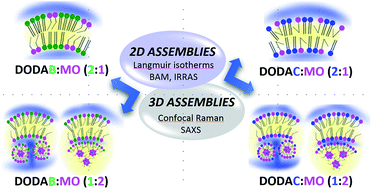Role of counter-ion and helper lipid content in the design and properties of nanocarrier systems: a biophysical study in 2D and 3D lipid assemblies†
Abstract
There is a direct correlation between the physicochemical properties of nanocarrier systems and their biological performance, including stability under physiological conditions, cellular internalization and transfection efficiency. Therefore, understanding the biophysical aspects that affect self-assembled nanocarriers is determinant for a rational design of efficient formulations. In this study, a comprehensive evaluation of the effects of each component on the molecular organization of aggregates formed by the cationic lipids dioctadecyldimethylammonium bromide and chloride (DODAB and DODAC) and the neutral lipid monoolein (MO) was made. Specifically, the effects of the helper lipid content (MO) and the role of the counter-ion of the cationic lipids were evaluated in 2D and 3D assemblies by Langmuir surface pressure–molecular area (π–A) isotherms, Brewster Angle Microscopy (BAM), infrared reflection absorption spectroscopy (IRRAS), confocal Raman microscopy, and Small Angle X-ray Scattering (SAXS). The results show that MO has a different distribution on the DODAC and DODAB bilayers, and a fluidizing effect dependent on the MO content. For low MO molar ratios, the fluidizing effect was more pronounced in DODAC : MO mixtures, indicating a more homogeneous distribution of MO in DODAC than in DODAB bilayers. For high MO molar ratios, packing of membranes was similar for both cationic lipids, and the effect of the counter-ion is attenuated. The distribution of MO in the two cationic systems is closely related with the efficiency of the counter-ions in the screening of the charged group.

- This article is part of the themed collection: Editors' collection: Physical Chemistry of Colloids and Interfaces


 Please wait while we load your content...
Please wait while we load your content...